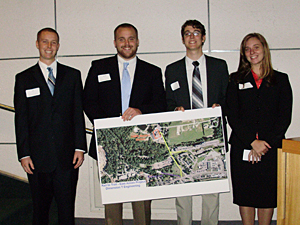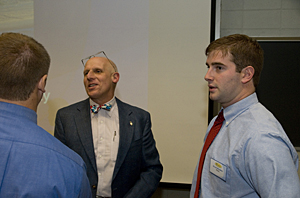

ADVERTISEMENT
- Rozovsky wins prestigious NSF Early Career Award
- UD students meet alumni, experience 'closing bell' at NYSE
- Newark Police seek assistance in identifying suspects in robbery
- Rivlin says bipartisan budget action, stronger budget rules key to reversing debt
- Stink bugs shouldn't pose problem until late summer
- Gao to honor Placido Domingo in Washington performance
- Adopt-A-Highway project keeps Lewes road clean
- WVUD's Radiothon fundraiser runs April 1-10
- W.D. Snodgrass Symposium to honor Pulitzer winner
- New guide helps cancer patients manage symptoms
- UD in the News, March 25, 2011
- For the Record, March 25, 2011
- Public opinion expert discusses world views of U.S. in Global Agenda series
- Congressional delegation, dean laud Center for Community Research and Service program
- Center for Political Communication sets symposium on politics, entertainment
- Students work to raise funds, awareness of domestic violence
- Equestrian team wins regional championship in Western riding
- Markell, Harker stress importance of agriculture to Delaware's economy
- Carol A. Ammon MBA Case Competition winners announced
- Prof presents blood-clotting studies at Gordon Research Conference
- Sexual Assault Awareness Month events, programs announced
- Stay connected with Sea Grant, CEOE e-newsletter
- A message to UD regarding the tragedy in Japan
- More News >>
- March 31-May 14: REP stages Neil Simon's 'The Good Doctor'
- April 2: Newark plans annual 'wine and dine'
- April 5: Expert perspective on U.S. health care
- April 5: Comedian Ace Guillen to visit Scrounge
- April 6, May 4: School of Nursing sponsors research lecture series
- April 6-May 4: Confucius Institute presents Chinese Film Series on Wednesdays
- April 6: IPCC's Pachauri to discuss sustainable development in DENIN Dialogue Series
- April 7: 'WVUDstock' radiothon concert announced
- April 8: English Language Institute presents 'Arts in Translation'
- April 9: Green and Healthy Living Expo planned at The Bob
- April 9: Center for Political Communication to host Onion editor
- April 10: Alumni Easter Egg-stravaganza planned
- April 11: CDS session to focus on visual assistive technologies
- April 12: T.J. Stiles to speak at UDLA annual dinner
- April 15, 16: Annual UD push lawnmower tune-up scheduled
- April 15, 16: Master Players series presents iMusic 4, China Magpie
- April 15, 16: Delaware Symphony, UD chorus to perform Mahler work
- April 18: Former NFL Coach Bill Cowher featured in UD Speaks
- April 21-24: Sesame Street Live brings Elmo and friends to The Bob
- April 30: Save the date for Ag Day 2011 at UD
- April 30: Symposium to consider 'Frontiers at the Chemistry-Biology Interface'
- April 30-May 1: Relay for Life set at Delaware Field House
- May 4: Delaware Membrane Protein Symposium announced
- May 5: Northwestern University's Leon Keer to deliver Kerr lecture
- May 7: Women's volleyball team to host second annual Spring Fling
- Through May 3: SPPA announces speakers for 10th annual lecture series
- Through May 4: Global Agenda sees U.S. through others' eyes; World Bank president to speak
- Through May 4: 'Research on Race, Ethnicity, Culture' topic of series
- Through May 9: Black American Studies announces lecture series
- Through May 11: 'Challenges in Jewish Culture' lecture series announced
- Through May 11: Area Studies research featured in speaker series
- Through June 5: 'Andy Warhol: Behind the Camera' on view in Old College Gallery
- Through July 15: 'Bodyscapes' on view at Mechanical Hall Gallery
- More What's Happening >>
- UD calendar >>
- Middle States evaluation team on campus April 5
- Phipps named HR Liaison of the Quarter
- Senior wins iPad for participating in assessment study
- April 19: Procurement Services schedules information sessions
- UD Bookstore announces spring break hours
- HealthyU Wellness Program encourages employees to 'Step into Spring'
- April 8-29: Faculty roundtable series considers student engagement
- GRE is changing; learn more at April 15 info session
- April 30: UD Evening with Blue Rocks set for employees
- Morris Library to be open 24/7 during final exams
- More Campus FYI >>
2:35 p.m., April 13, 2010----The University of Delaware's Department of Civil and Environmental Engineering has received top honors in a competition sponsored by the National Council of Examiners for Engineering and Surveying (NCEES). The award rewards college engineering programs for engaging their students in collaborative projects with licensed professional engineers.
The NCEES Engineering Award for Connecting Professional Practice and Education recognized UD's civil and environmental senior design course (CIEG461). Each year, the two-semester capstone class focuses on an actual site undergoing construction, renovation, or development in Delaware.
The 78 students in the Class of 2009 addressed expansion and enhancement of a multi-user trail system in the city of Newark. The Pomeroy Trail East Annex Project, scheduled for completion in 2011, will connect the existing James F. Hall Trail with the University's north campus.
The competition was judged by a jury of NCEES members and representatives from academic institutions and professional engineering organizations. The jury praised the project for a number of elements, including its excellent integration of real-world experience in an educational setting, great impact on raising social consciousness, and outstanding report and work deliverables.
The course is coordinated by Michael Paul, a professional engineer at Duffield Associates, with support from an extensive team of practicing professionals who serve as mentors and instructors. Organized into six teams, the students create plans for the execution of the work, develop proposals to win the commission for the project, write engineering reports documenting the preliminary design, and deliver formal presentations to a panel of experts.
“The concept of a real-world commission based on an actual local project and carried out by teams of students working in a multidisciplinary environment was initiated here at UD in the late 1990s,” Paul says. “That concept totally changed the course for the students, providing them with an open-ended design experience that goes a long way toward preparing them for work in an engineering design firm when they graduate.”
The project encompassed a broad array of civil engineering challenges, including drainage and environmental upgrades, wastewater system improvements, reevaluation of a proposed groundwater remediation program, and associated infrastructure improvements.
According to Paul, the course features six fundamental elements that are essential for success in the working world: teamwork, multiple disciplines, multiple roles, a real project, communication, and professional issues -- for example, ethical and legal responsibilities, contractual relationships, and risk and liability.
The success of the class in incorporating these elements was validated by the review panel members, who commented that the course “demonstrated a variety of learning experiences for students that can lead them into a high level of professional, competent, and ethical practice at an early stage in their careers.”
“This project is especially relevant now,” said Jerry Kauffman, a member of the Newark Bicycle Committee, “as U.S. Transportation Secretary Ray Hood recently announced President Obama's intentions to bring bicycling and bike paths on par with motorized transportation in terms of focus and priority and perhaps funding as well.” The bicycle committee has been a strong proponent of trail development within and around the city and the UD campus, including the Pomeroy Trail.
“This award is another example of the outstanding work being done by our students,” says chairperson Harry W. (Tripp) Shenton. “It is a testament to them and to Michael Paul and the entire team of adjunct faculty that teach the class.”
The jury also lauded the project for its involvement and development of practicing professionals throughout the project. The group included, in addition to Michael Paul, Ronnie Carpenter (Carpenter Engineering), Paul Butler (URS Corporation), and Philip Horsey and Ted Januszka (Pennoni Associates).
“It's great to see these innovative approaches to teaching students about professional practice,” said NCEES President David Whitman. “We hope they inspire other colleges to try similar collaborations.”
UD won the NCEES grand prize, consisting of a trophy and a $25,000 check to the department. Five additional winners -- California Polytechnic State University, California State University, Clemson University, the University of Maryland, and the University of New Mexico -- received awards of $7,500 each.
Article by Diane Kukich


